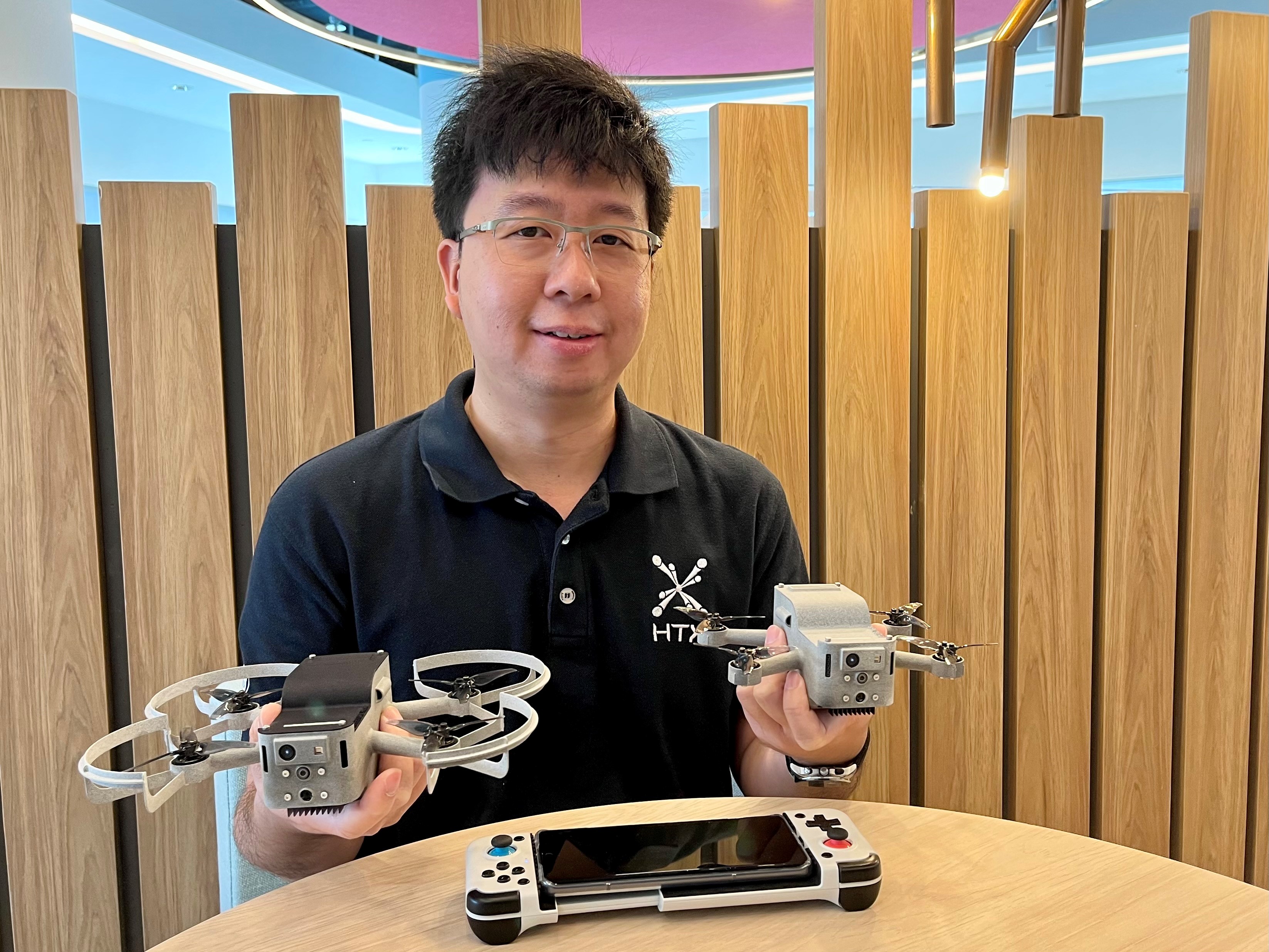
Low Hsien Meng is developing a palm-sized, cellular, beyond visual line of sight drone for indoor use.
(Photo: HTX/ Michelle Lim)
Meet Low Hsien Meng, an engineer at HTX who has been working on developing new and innovative drone technology. His latest creation – Project APERTURE – is a potential game-changer in the world of drones, and it has the potential to revolutionise
the way that we use these machines.
Project APERTURE is a palm-sized, cellular, unmanned aerial vehicle (UAV), or commonly known as drone, that can operate Beyond Visual Line of Sight (BVLOS). The drone was specially developed in-house
by engineers from HTX’s Robotics, Automation & Unmanned Systems Centre of Expertise (RAUS CoE) to address
the challenges faced in operating conventional drones indoors.
Innovating to reach for the skies
Hsien Meng's passion for engineering and began at a young age. As a child, he would spend hours tinkering with gadgets and machines,
trying to figure out how they worked and how he could make them better. This curiosity and drive for innovation stayed with him as he grew older, and eventually led him to pursue a degree in aerospace engineering.
After graduating from
university, Hsien Meng joined Singapore Technologies (ST) Engineering. He contributed to the development of DroNet, a BVLOS drone system that enables city-wide drone network applications such as facility or perimeter security, site inspections,
deliveries, and more.
In his current role as Lead Engineer (Aerial Systems) at HTX, Hsien Meng runs and manages projects involving aerial systems as well as works tirelessly on tech development projects – both in-house and
with external industry partners – with the RAUS Intelligence, Interactions & Inter-Ops (3i) team.
"We are working on enhancing the drone as commercial solutions are catching up, and we need to stay ahead of the curve."
Solving challenges operating conventional drones indoors
Interest in drones has been growing and the applications of drone technology extend well beyond taking aerial photos, performing spectacular aerial lightshows, aiding building inspection, or delivering packages.
BVLOS drones are useful to the Home Team for patrolling and security operations in areas that may be inaccessible or in situations that are too risky for officers. They can also play a critical role in the detection of hazardous materials, monitor fire scenes, and deliver essential supplies such as Automated External Defibrillators (AEDs).
Read related article: HTX's First Long-Distance BVLOS flights a milestone for Home Team Ops
However, indoor environments present multiple challenges to operating drones, such as limited space, potential for collisions with objects or people, and the inability to position reliably without a Global Navigation Satellite System like GPS. The operating range of a remote controller’s radio frequency signal is limited as it cannot penetrate beyond several layers of concrete wall.
“There are unique tactical needs of the Home Team that require the use of a drone indoors. But conventional drones are often too large for indoor use. They also have limited radio frequency transmission range indoors and have trouble maintaining stability and position without a Global Navigation Satellite System (GNSS),” said Hsien Meng, who spent about six months developing the system.
To address the challenges of operating conventional drones indoors, a small, lightweight, and cellular-linked drone for indoor use that is packed with advanced sensors and cameras was developed.
“We realised that there was a gap in the market and a system with this combination of features did not exist. So we started this project to bridge the gap,” Hsien Meng explained.
The innovative drone weighs just 250g and has forward-facing visual sensors that enable it to hold its position and maintain the right speed and trajectory. It relies on cellular datalink over VPN, which allows it to operate no matter how far or deep the UAV traverses into the building. Additional features or unconventional functions can also be easily and quickly integrated in the future.
Navigating the design and manufacturing journey
As there were no drones in the market with the unique set of features – lightweight, palm-sized, indoor localisation, and cellular datalink over VPN – when Hsien
Meng first embarked on the project in February 2022, he had to develop one himself.
There were numerous challenges he had to overcome including structural design and manufacturing; propulsion design; and thermal design.
For example, the aircraft structure had to be lightweight and sufficiently strong. Other design and manufacturing concerns included ensuring minimum wall thickness, minimum feature size, isotropic mechanical/material properties, glass
transition temperature, and support materials. After a laborious process, he eventually landed on an industrial 3D printing process to manufacture the drone.
Technologies from adjacent industries such as mobile hardware
architecture, open-source software, and additive manufacturing, were adopted to produce a minimum viable product.
The project is now moving into its next stage of development.
“We are working on
enhancing the drone as commercial solutions are catching up, and we need to stay ahead of the curve,” Hsien Meng said.
“I believe that drone technology has the potential to greatly improve our lives and make
a positive impact to support the society and Home Team,” Hsien Meng said. “I can't wait to see what the future holds for drones.”
Read related article: Exploring exciting innovations at HTX TechXplore 4
We are always seeking inquisitive and innovative individuals to co-create extraordinary solutions with us.
Join us to be at the forefront of the finest tech capabilities in the field! Join Us

